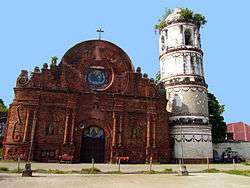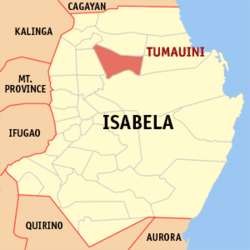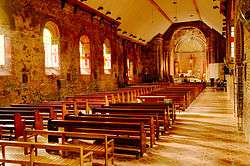Tumauini
Tumauini, officially the Municipality of Tumauini (Ibanag: Ili nat Tumauini; Ilocano: Ili ti Tumauini; Tagalog: Bayan ng Tumauini), is a 1st class municipality in the province of Isabela, Philippines. According to the 2015 census, it has a population of 67,650 people.[3]
Tumauini | |
|---|---|
| Municipality of Tumauini | |
 Façade of St. Mathias Parish Church | |
 Seal | |
 Map of Isabela with Tumauini highlighted | |
OpenStreetMap 
| |
.svg.png) Tumauini Location within the Philippines | |
| Coordinates: 17°16′N 121°48′E | |
| Country | |
| Region | Cagayan Valley (Region II) |
| Province | Isabela |
| District | 1st District of Isabela |
| Founded | 1751 |
| Barangays | 46 (see Barangays) |
| Government | |
| • Type | Sangguniang Bayan |
| • Mayor | Arnold S. Bautista |
| • Vice Mayor | Lorenzo B. Uy, Jr. |
| • Congressman | Antonio T. Albano |
| • Electorate | 43,125 voters (2019) |
| Area | |
| • Total | 467.30 km2 (180.43 sq mi) |
| Population (2015 census)[3] | |
| • Total | 67,650 |
| • Density | 140/km2 (370/sq mi) |
| • Households | 14,862 |
| Economy | |
| • Income class | 1st municipal income class |
| • Poverty incidence | 18.05% (2015)[4] |
| • Revenue (₱) | 189,489,503.42 (2016) |
| Time zone | UTC+8 (PST) |
| ZIP code | 3325 |
| PSGC | |
| IDD : area code | +63 (0)78 |
| Climate type | tropical rainforest climate |
| Native languages | Ibanag Ilocano Tagalog |
| Website | www |
The Tumauini Church is currently in the tentative list for UNESCO World Heritage Sites under the Baroque Churches of the Philippines (Extension). A proposal has been suggested by scholars to make a separate UNESCO inclusion for the Old Centre of Tumauini which includes the Tumauini Church. The same would be made for other churches listed in UNESCO's tentative sites, where each town plaza and surrounding heritage buildings would be added. No government agency has yet to take action on the proposal.
Geography
Tumauini is located at the northern portion of the province of Isabela. Its land area is 46,730 hectares (115,500 acres) or 5.62% of the total land area of Isabela. It is bounded on the north by the municipality of Cabagan and 68 kilometres (42 mi) south from Tuguegarao (the Regional Center); on the east by the municipality of Divilacan, on the south by the City of Ilagan, the capital of Isabela (30 kilometres (19 mi) away) and 445 kilometres (277 mi) north from Manila; on the west by the Cagayan River and the municipality of Delfin Albano.
Barangays
Tumauini is politically subdivided into 46 barangays. [2] Four (4) of which compose the center of the city whereas the other forty two (42) are in the outlying areas. Some of them are even several kilometers away from the center of the municipality. The most populous are Sisim Abajo, Fugu Sur, Sinippil, Santa Catalina, Tunggui, Lalauanan, San Vicente, Malamag East, Barangay District 2 (Poblacion), Fugu Norte, Banig, Malamag West, Barangay District 4 (Poblacion), Fugu Abajo, Barangay District 1 (Poblacion).
| Barangay | Population (2010)[5] | Punong Barangay (2013-2016) |
|---|---|---|
Climate
| Climate data for Tumauini, Isabela | |||||||||||||
|---|---|---|---|---|---|---|---|---|---|---|---|---|---|
| Month | Jan | Feb | Mar | Apr | May | Jun | Jul | Aug | Sep | Oct | Nov | Dec | Year |
| Average high °C (°F) | 29 (84) |
30 (86) |
32 (90) |
35 (95) |
35 (95) |
35 (95) |
34 (93) |
33 (91) |
32 (90) |
31 (88) |
30 (86) |
28 (82) |
32 (90) |
| Average low °C (°F) | 19 (66) |
20 (68) |
21 (70) |
23 (73) |
23 (73) |
24 (75) |
23 (73) |
23 (73) |
23 (73) |
22 (72) |
21 (70) |
20 (68) |
22 (71) |
| Average precipitation mm (inches) | 31.2 (1.23) |
23 (0.9) |
27.7 (1.09) |
28.1 (1.11) |
113.5 (4.47) |
141.4 (5.57) |
176.4 (6.94) |
236.6 (9.31) |
224.9 (8.85) |
247.7 (9.75) |
222.9 (8.78) |
178 (7.0) |
1,651.4 (65) |
| Average rainy days | 10 | 6 | 5 | 5 | 13 | 14 | 15 | 15 | 15 | 17 | 16 | 15 | 146 |
| Source: World Weather Online[6] | |||||||||||||
History
The name of Tumauini originated from the name of the big trees found in the poblacion called "Mauini". It is said that when some Spaniard wanted to know the name of the trees, they asked a native saying, "Como se llama el grande lenia? Sabes tu?" The native not knowing what the Spaniards said, picked the last word he heard and answered "Tumauini".
In 1952, the barrios of Barucbuc, Siempre Viva, Bimmonton, Pasurgong, Manga, and Settlement No. 1 were transferred to the newly created town of Mallig.[7]
In 1957, the barrios of San Antonio, San Juan, Ragan Sur, Ragan Norte, Ragan Almacen, San Jose (Bulo), San Patricio, Quibal, San Andres (Lattu), Calinawan Sur, Bayabo, Santor, Santo Rosario, Andarayan, Aneg, San Isidro, Mawi, San Roque, Carmencita, Aga, Villa Pareda, Villaluz, San Pedro, Concepcion, Sammabario and San Nicolas and the sitios of Turod, Paco, Calamagui and Kim-malabasa, were separated from the municipality of Tumauini to form the town of Magsaysay.[8] Camp Samal used to be the camp of guerillas in 1945 World War II, and Camp Samal had been also used by the Filipino American troops against the Japanese invasion, and SAMAL derives from SA means Sadornas, and MAL from Malana.
Demographics
| Year | Pop. | ±% p.a. |
|---|---|---|
| 1903 | 4,890 | — |
| 1918 | 7,147 | +2.56% |
| 1939 | 14,343 | +3.37% |
| 1948 | 19,190 | +3.29% |
| 1960 | 16,606 | −1.20% |
| 1970 | 23,427 | +3.50% |
| 1975 | 27,669 | +3.39% |
| 1980 | 31,967 | +2.93% |
| 1990 | 40,664 | +2.44% |
| 1995 | 45,551 | +2.15% |
| 2000 | 50,256 | +2.13% |
| 2007 | 55,041 | +1.26% |
| 2015 | 67,650 | +2.61% |
| Source: Philippine Statistics Authority[3][9][10][11] | ||
In the 2015 census, the population of Tumauini was 67,650 people,[3] with a density of 140 inhabitants per square kilometre or 360 inhabitants per square mile.
Economy
Over the past years, the town's economy had dramatically shifted from stagnant to a fast-moving basis. Aside from agriculture being the main backbone of the town's economy, commerce and trade also became the second economic-based income of the town and its residents with the opening of numerous business establishments, hotels and financial institutions that generated many opportunities and more employment for its residents. In 2015, SM Prime opened its first branch of Savemore Market in the town along National Highway while Puregold, a large retail chain opened its first Puregold Price Club Store in the same year. Multi-national fast food chain like Jollibee opened their first branch in the area in 2017. Other fast food chains like McDonald's and Mang Inasal will soon put up their branches which will be located in Xentro Mall, the town's first mall. Banking institutions like BDO Unibank, Development Bank of the Philippines, Producers Bank, FICO Bank and other smaller financial institutions put up their branches in the town which is a good indication that the town is gearing towards rapid commercialization. In 2019, another fast food chain like 7-Eleven is already open.
Local government
| Position | Name of official |
|---|---|
| District Representative (1st Legislative District of Isabela) | Rep. Antonio T. Albano |
| Municipal Mayor | Arnold S. Bautista |
| Municipal Vice Mayor | Lorenzo B. Uy Jr. |
| Municipal Councilors | Sharina Lu B. Medrano |
| Mark Anthony M. De Alban | |
| James Pua | |
| William Uy | |
| Reonel G. Gardon | |
| Ruth D. Padilla | |
| Jun Dammog | |
| Rolando Managuelod | |
Attractions
This quiet town boasts of a famous historical landmark, the Tumauini Church. Built in the 1780s by the Dominicans, the church has a unique cylindrical bell tower made of bricks. Also one of the popular tourist attraction of the town is the Camp Samal Resort and Leisure Park where known as a semi-Tagaytay because of being high on its location where can view the entire town in the west, south and north and the Cordillera Sierra Madre in the east.
San Matias Parish Church

The Parish Church of San Matias was built in the 1780s by the Dominicans. This is the best-preserved church ensemble in Isabela although its convento is in ruins. The church can be considered to be the best and most artistic brick structure in the Philippines. The delicate brickwork is evident in the church itself and also in the cylindrical, confectionery-like bell tower (a later addition). In the convento's vaulted ceiling may still be seen impressions of the mats that were used as forms to mold wet plaster during construction. A low, undulating brick wall circumscribes the front garden. [PDI, Dec 16, 2001]
First build of light materials by Francisco Nunez O. P., and dedicated to the Patron Saint, 1707. Separated from Cabagan and became a regular parish in 1751. The Roman Catholic Church was erected by the Dominican in 1753. They were made of bricks and coral stones with unique cylindrical bell tower, the only of its kind in the Philippines was constructed by Fr. Domingo Forto in 1793 and completed on 1805, became the capital of Isabela for sometimes in the 1880s. The Church was partly damaged during World War II and repaired into original form by the faithful of Tumauini.
Furthermore, the church architectural design bear traces of Chinese artistry which confirms the belief that long before the Spaniards came to the Philippines, the Chinese had settled in the coastal towns of Northern Luzon.
By virtue of Presidential Decree # 260, 11 August 1973, as amended by Executive Order No. 357, 14 January 1974 and No. 1505, 11 June 1978, the Church of Tumauini was declared a National Historical Landmark on February 24, 1989.
Camp Samal
The historic Camp Samal was the site of the National Jamboree in 1977 and is the home of the Boy Scouts of the Philippines. It is located at the eastern outskirts of the Spanish – built town of Tumauini, on a 23.5 hectares (58 acres) of elevated mass of rolling hills 500 feet above sea level. It is endowed with natural spring, evergreen grasses, trees and shrubs. It overlooks the Cagayan River, the Pinacanauan River, the town of Tumauini itself, the municipality of Delfin Albano, and the Sierra Mountain ranges.
Its name was derived from the first syllable of the surnames of the spouses, Ricardo C. Sadornas and Purificacion Malana who donated the camp to the Boy Scout of the Philippines in 1954. After the holding of the 1977 National Jamboree, the camp slept for 26 years until the assumption of Arnold S. Bautista in July 2001 as Municipal Mayor, who drew out the support of the government and private sectors for its restoration and development. It is still the favorite destination of the Boy Scout and Girl Scouts of the Philippines for their annual district and provincial encampments. It hosted another big event which is the 5th Northeastern Luzon Regional and Ilocos Region Invitational Jamboree of the Boy Scouts of the Philippines held last November 25 – 30, 2004 with a total of 5,281 participants.
Mangi Festival
Patronal town fiesta in honor to St. Mathias and the promotion of Tumauini as source of corn and its by-products. Tumauini is also the home of St. Mathias Church, a Spanish brick colonial church (1753) with the only cylindrical belfry in the country and is considered a national cultural treasure.
One of the most enduring legacies of the Spanish colonial era lives on, quite literally in Tumauini, corn (Zea mays). It was one of the plants that came aboard the galleons and became one of the primary crops of the Philippines. Corn seems to have transcended being a mere crop in Tumauini. The late National Artist for Dance, Ramon Obusan traced the origins of a traditional dance inspired by the crop to Tumauini. Thus, a corn inspired festival seemed especially appropriate for Tumauini.[12]
Magoli River
Threading highways and byways of Antagan 1st is a quiet river which locked a natural beauty, beauty that holds thousands of souls, beauty that makes up life abundant. Magoli River is one of the many prides of Tumauini and considered as the most well-known tourist destination in town because of its perfect location that shows the refreshing view of the mountains and hills. Water from its fresh flowing river gives an unlimited supply of water in many irrigation, farms and households. In its heart lies the invigorating view of Blue Lagoon, a place where you can find inner peace. Blue Lagoon will show you how majestic the work of our creator is. Deep blue water and natural artistic water-shone, curved through time, will be seen in this seen. In the middle of the long running river, there are two life-size rocks called by the natives as Kambal na Bato which also served as a tourist attraction because of its oddity and beauty that no place can ever have.
Impact of COVID-19 Pandemic
Due to ongoing pandemic, many establishments implement "Social Distancing" and "No Face, Mask No Enter". The locally stranded undergo testing and quarantine for 14 days. Many Schools both Private and Public have been closed and they plan to go in new normal education called "Online Classes". Tourist attraction like Mangi Festival and Magoli River has been closed since March 15 to this day. No further notice include. Churches are now using Live Broadcast through Facebook Live due to ongoing pandemic.
References
- "Municipality". Quezon City, Philippines: Department of the Interior and Local Government. Retrieved 31 May 2013.
- "Province: Isabela". PSGC Interactive. Quezon City, Philippines: Philippine Statistics Authority. Retrieved 12 November 2016.
- Census of Population (2015). "Region II (Cagayan Valley)". Total Population by Province, City, Municipality and Barangay. PSA. Retrieved 20 June 2016.
- "PSA releases the 2015 Municipal and City Level Poverty Estimates". Quezon City, Philippines. Retrieved 1 January 2020.
- "Total Population by Province, City, Municipality and Barangay: as of May 1, 2010" (PDF). 2010 Census of Population and Housing. Philippine Statistics Authority. Retrieved 9 January 2014.
- "Tumauini, Isabela: Average Temperatures and Rainfall". World Weather Online. Retrieved 31 October 2015.
- "R.A. No. 678, An Act Creating the Municipality of Mallig in the Province of Isabela". LawPH.com. Retrieved 2011-04-09.
- "R.A. No. 2009, An Act Creating the Municipality of Magsaysay in the Province of Isabela". LawPH.com. Retrieved 2011-04-13.
- Census of Population and Housing (2010). "Region II (Cagayan Valley)". Total Population by Province, City, Municipality and Barangay. NSO. Retrieved 29 June 2016.
- Censuses of Population (1903–2007). "Region II (Cagayan Valley)". Table 1. Population Enumerated in Various Censuses by Province/Highly Urbanized City: 1903 to 2007. NSO.
- "Province of Isabela". Municipality Population Data. Local Water Utilities Administration Research Division. Retrieved 17 December 2016.
- "Mangi Festival". spcicdtourism.com. Retrieved 10 October 2014.
External links
| Wikimedia Commons has media related to Tumauini, Isabela. |
- Tumauini Profile at PhilAtlas.com
- Tumauini on Facebook
- Municipal Profile at the National Competitiveness Council of the Philippines
- Tumauini at the Isabela Government Website
- Local Governance Performance Management System
- Philippine Standard Geographic Code
- Philippine Census Information
- Municipality of Tumauini